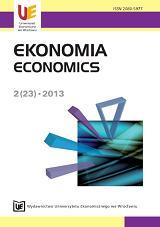Struktura zatrudnienia a nierówności i zagrożenia społeczne w gospodarkach UE
Structure of employment versus social inequalities and risks in UE economies
Author(s): Magdalena CyrekSubject(s): Economy
Published by: Wydawnictwo Uniwersytetu Ekonomicznego we Wrocławiu
Keywords: employment; sectoral structure; social inequalities
Summary/Abstract: Structural features of economies constitute disregarded aspects of relations between economic development and social issues. Economic research on inequalities are focused on connections between income disparities and economic growth. Independently, sectoral characteristics of economies are evaluated taking into account their influence on dynamics of growth. The existence of both mainstreams in research pays attention to interrelations: social inequalities and risks – sectoral structure. This is a field of discussion in the study. The aim of the paper is to verify the existence of relations between sectoral structure and social inequalities and risks. The analyses were conducted concerning EU economies, that, despite intensive integration process, are still differentiated by the level of socio-economic development. The starting hypothesis assumed positive influence of structural modernity on limiting social problems. The structure of economies was described by shares in employment of three sectors e.g. agriculture, industry and services as well as by shares in employment of the service sector sections (G-U NACE Rev. 2). Structural modernity was assessed using a model, which was adopted using Luxembourg as the most developed economy in the EU. Social issues were considered in their economic dimension. That is why they were described by the most commonly used indicators of income inequalities that are Gini coefficient and income quintile share ratio (S80/20) and by the rate of risk of poverty or social exclusion. Statistics in use were extracted from Eurostat database and cover the most up-to-date information accessible while preparing the paper that is 2011 year. The analyses were based on correlation indicators that were statistically verified at significance level of α = 0,05. Indicators that characterized total employment relationships in every economy were counted with the usage of Kukuła measure of structural differences.
Journal: Ekonomia
- Issue Year: 2013
- Issue No: 23
- Page Range: 49-63
- Page Count: 15
- Language: Polish

